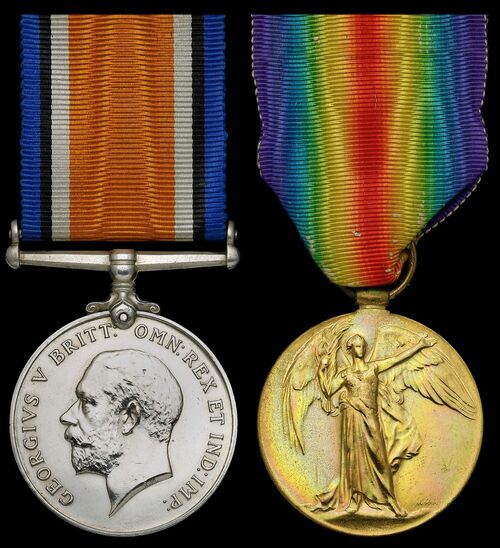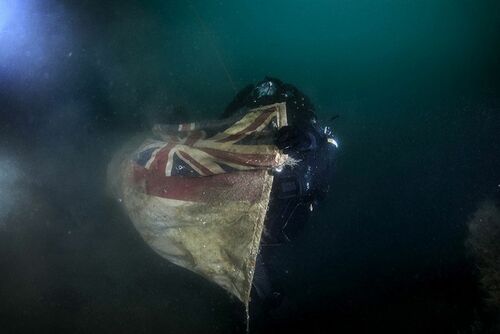Auction: 23112 - Orders, Decorations and Medals - e-Auction
Lot: 523
'H.M.S. Vanguard was blown up in Scapa Flow Harbour on the night of July 9th, 1917, with a loss of over 800 lives. The only relic recovered at the time was a framed photo, which was blown three miles, and which was presented to the Bishop of London, who said at the time he should ever treasure this memento (his lordship was in the group taken on the ship) of his visit to Vanguard.
This week another relic has reached Willand. On the ship was George William Ellis Lee only son of a Willand schoolmaster. Walking along the shore at Scapa Flow, Sergt. Russell of H.M.S. Imperieuse, picked up a diary, from the entries in which he was promoted to send it to Miss Dorothy Jarrett, Tiverton Junction (the deceased's fiancé). The diary belonged to the late officer, as is proved by entries therein. It was given to Mr Lee by Miss Jarrett seven years ago as a birthday gift.'
(The tragic story of George Lee's doomed romance, Western Times, 5 December 1918, refers)
An H.M.S. Vanguard casualty's pair awarded to Ship's Steward's Assistant G. W. E. Lee, Royal Navy, a Jutland Veteran who was killed in action during the destruction of Vanguard and whose diary, found floating in Scapa Flow some 18 months later, was to be one of the few artifacts recovered from the tragedy
British War and Victory Medals (M.23273 W. G. Lee. S.S.A. R.N.), sold together with their named box of issue, nearly extremely fine (2)
Provenance:
D.N.W. April 2001.
George William Ellis Lee was born at Caltestock, Dorset on 11 October 1894 the son of Samuel and Jane Lee of the School House, Cullompton, Devon. His father worked as the headmaster of Willand School and the younger lee, received a sterling education at Hele's School, Exeter and Tiverton Middle School. Becoming a teacher himself upon graduating he taught at Heathcoat Boy's School, Tiverton and later Saltney College, Birmingham.
Joining the Royal Navy at Vivid I on 28 January 1916 as Ship's Steward's Assistant, Lee was soon posted to the Battleship Vanguard on 2 March. Part of the 4th Battle Squadron under Captain Dick she joined Beatty's Grand Fleet during the Battle of Jutland on 31 May 1916. The 16th ship in the British line she fired 80 of her 12-inch shells over the course of the Battle, sustaining no hits herself.
Returning to the base at Scapa Flow, Vanguard had just completed a round of exercises on 9 July 1917 and was lying at anchor with the rest of the fleet. Workmen came aboard to help refit the ships guns and a concert aboard Royal Oak attracted a number of officers who left the ship for the entertainment as evening set it. A summary of the subsequent events can be found on the Scottish Ship Wrecks website which states:
'Gradually the lights round the anchorage flickered out as many of the sailors settled down for the night ready for their early watch the next day. At around 11:20pm the half dark evening was illuminated by a huge flame that shot up from the Vanguard aft of her foremast. Almost immediately the stillness was shattered by a massive explosion and the hillsides round Scapa were lit up by a gigantic fireball from the ship. A second even larger explosion followed which extinguished the flames and, as the smoke cleared, the Vanguard had disappeared. Around the anchorage burning wreckage rained down on the fleet - a large piece landed on the deck of HMS Belleraphon anchored next in line to the Vanguard - another, a complete 12" gun turret weighing over 400 tons, landed on Flotta nearly a mile away.'
Of the 845 men who were aboard the ship only the sixteen officers on Royal Oak and two astonishingly lucky sailors who were flung clear lived. One further man flung clear of the destruction survived for some time but was unable to recover from his injuries. In the wake of the wreck a court of inquiry was convened which, strangely did not come to a satisfactory verdict, stating that the explosion could have been a result of unstable cordite detonating but not ruling out sabotage.
Lee was killed in the explosion with only his diary remaining, astonishingly it stayed intact and was recovered over a year later, the Western Times expands stating:
'The diary is much weather and sea water stained, but all the entries therein are decipherable. Its recovery in this remarkable way, 18 months after the tragedy, has, of course, given melancholy satisfaction both to Mr. and Mrs. Lee and to Miss Jarrett, who are very grateful to the finder for his kind thought in forwarding it to them.'
He is commemorated upon the Plymouth Naval Memorial; sold together with copied research comprising Commonwealth War Graves certificate, an extract from the Western Times, service papers, Royal Navy and Royal Marine War Graves Roll and De Ruvigny's Roll of Honour extract.
Subject to 20% VAT on Buyer’s Premium. For more information please view Terms and Conditions for Buyers.
Sold for
£130
Starting price
£70







